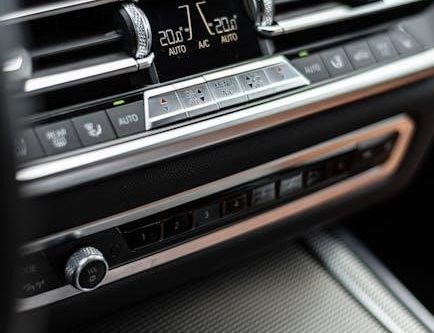Manual air vents are essential components in heating systems, designed to release trapped air and prevent airlocks. They ensure efficient system operation and longevity by eliminating gas buildup.
1.1 Definition and Purpose
A manual air vent is a valve or device designed to release trapped air from plumbing or heating systems. Its primary purpose is to eliminate airlocks, ensuring proper fluid flow and system efficiency. By allowing air to escape, it prevents pressure buildup and potential damage. Typically installed at high points in the system, manual air vents require human intervention to operate, making them a simple yet essential component for maintaining system performance and longevity. They are crucial for both residential and commercial applications, particularly in radiators and heating circuits. Regular use ensures optimal functionality and prevents common issues like reduced heat output or system failure. Proper installation and maintenance are key to their effectiveness in safeguarding the system from air-related problems, ensuring reliable operation and extending the lifespan of the equipment. Additionally, manual air vents play a vital role in fire sprinkler systems by preventing corrosion and meeting safety standards like NFPA 13. Their versatility and importance make them a fundamental part of modern heating and plumbing solutions, addressing both efficiency and safety concerns effectively. Overall, manual air vents are indispensable for maintaining the health and efficiency of various systems, ensuring they function as intended without interruption. Their simple design belies their critical role in system maintenance, making them a cornerstone of hydraulic and heating systems worldwide. By providing a manual means to vent air, they offer a reliable solution to a common problem, ensuring systems run smoothly and efficiently. Their widespread use across industries underscores their value and necessity in maintaining operational integrity. Thus, manual air vents remain a vital tool for system maintenance, offering a straightforward yet effective solution to air-related issues. In summary, they are essential for ensuring the proper functioning of heating and plumbing systems by effectively managing air accumulation. Without manual air vents, systems would be prone to inefficiencies and potential damage, highlighting their importance in modern infrastructure. Their role in preventing airlocks and ensuring smooth operation makes them a crucial component for any system reliant on fluid flow. As such, manual air vents are a fundamental part of maintaining the integrity and performance of heating and plumbing systems worldwide. They provide a simple yet effective solution to a common problem, ensuring systems operate at peak efficiency and reliability. By addressing air accumulation issues, manual air vents play a pivotal role in safeguarding system longevity and performance. Their importance cannot be overstated, as they are integral to the proper functioning of various applications, from residential heating to large-scale industrial systems. In conclusion, manual air vents are a cornerstone of system maintenance, offering a reliable and efficient means of managing air in plumbing and heating systems. Their continued use ensures the optimal performance and longevity of these systems, making them an indispensable tool for modern infrastructure. With their simple design and critical function, manual air vents remain a vital component in maintaining the integrity of hydraulic and heating systems, ensuring they operate without interruption or inefficiency. Their role in preventing air-related issues underscores their necessity, making them a fundamental part of system maintenance practices worldwide. As such, manual air vents are an essential tool for anyone involved in the installation, maintenance, or operation of heating and plumbing systems, providing a straightforward solution to a common challenge. By incorporating manual air vents into system design, engineers and technicians can ensure optimal performance, reliability, and longevity, safeguarding against the adverse effects of air accumulation. In summary, manual air vents are a simple yet crucial component, playing a vital role in the efficient operation of heating and plumbing systems by effectively managing air within the system. Their importance is evident in their widespread use and the critical function they serve, making them an indispensable part of modern infrastructure. By understanding the definition and purpose of manual air vents, one can appreciate their significance in maintaining the health and efficiency of various systems, ensuring they function as intended without the hindrance of air-related issues. Thus, manual air vents are a fundamental tool in the toolkit of anyone working with hydraulic or heating systems, offering a reliable means of managing air accumulation and preventing potential problems. Their continued relevance and necessity in modern applications highlight their importance as a cornerstone of system maintenance, ensuring the optimal performance and longevity of plumbing and heating systems worldwide.
1.2 Brief History of Manual Air Vents
Manual air vents have their roots in the early 19th century, emerging alongside advancements in plumbing and heating systems. Initially simple in design, they were crafted from materials like brass and bronze to ensure durability. Their development paralleled the rise of steam heating systems, where airlocks were a common issue. Over time, designs evolved to incorporate improved materials and mechanisms, enhancing reliability. By the 20th century, manual air vents became standardized components, with modern versions integrating new technologies for better performance. Their historical progression reflects the growing need for efficient heating and plumbing solutions, making them a cornerstone of modern systems. Today, they remain essential for maintaining system integrity, building on a legacy of innovation and practicality. Their enduring relevance underscores their importance in addressing air-related challenges across generations of infrastructure development. As systems grow more complex, manual air vents continue to adapt, ensuring their longevity as vital components in heating and plumbing. Their evolution mirrors the advancements in material science and engineering, solidifying their role in modern applications. From humble beginnings to modern sophistication, manual air vents have consistently provided reliable solutions to airlock issues, earning their place as indispensable tools in system maintenance. Their historical journey highlights a commitment to functionality and efficiency, ensuring they remain integral to heating and plumbing systems worldwide. The development of manual air vents reflects the continuous pursuit of improved performance and reliability, aligning with the demands of advancing technology and infrastructure needs. Their historical significance is a testament to their enduring utility and adaptability in addressing air-related challenges across various applications. As a result, manual air vents continue to be a fundamental component in maintaining the efficiency and longevity of heating and plumbing systems, both past and present. Their historical evolution demonstrates a steadfast dedication to solving airlock issues, ensuring their relevance in an ever-changing technological landscape. Through the centuries, manual air vents have proven to be a timeless solution, adapting to new demands while retaining their core functionality. Their historical development underscores their importance in the history of plumbing and heating systems, cementing their place as a crucial tool for generations to come. In conclusion, the history of manual air vents is a story of innovation and resilience, marking their transition from rudimentary devices to sophisticated components essential for modern infrastructure. Their enduring presence highlights their ability to evolve and meet the changing needs of heating and plumbing systems, ensuring their continued relevance in the future. As technology advances, manual air vents remain a testament to the ingenuity of early engineers and their ability to address fundamental challenges in system design. Their historical journey serves as a reminder of the importance of simple yet effective solutions in maintaining the integrity of complex systems. Thus, manual air vents stand as a legacy of practical innovation, continuing to play a vital role in the efficient operation of heating and plumbing systems worldwide. Their historical significance is a celebration of human ingenuity and the relentless pursuit of improved system performance, ensuring their place in the annals of engineering history. In summary, the history of manual air vents is a narrative of continuous improvement, reflecting the evolving needs of heating and plumbing systems while maintaining their core purpose of eliminating airlocks. Their historical development is a tribute to the enduring importance of addressing air-related challenges, securing their position as a cornerstone of modern infrastructure. By understanding their historical context, one can appreciate the significance of manual air vents in the broader story of technological progress and innovation. Their legacy continues to shape the way we approach system maintenance, ensuring that the lessons of the past inform the solutions of the future. As such, manual air vents remain a vital link between the historical roots of plumbing and heating systems and the advanced technologies of today, bridging the gap with their timeless functionality. Their historical journey is a testament to the power of simple, effective design in addressing complex challenges, ensuring their relevance across generations of infrastructure development. In conclusion, the history of manual air vents is a story of adaptability, innovation, and enduring utility, making them a cornerstone of modern heating and plumbing systems. Their historical evolution reflects the continuous pursuit of efficiency and reliability, securing their place as an indispensable tool in system maintenance. As technology progresses, manual air vents continue to adapt, ensuring their relevance in addressing air-related challenges in an ever-changing world. Their historical significance is a celebration of practical ingenuity and the enduring importance of solving fundamental problems in system design. Thus, manual air vents stand as a testament to the power of innovation and the human spirit’s ability to create lasting solutions to everyday challenges. Their historical journey is a reminder of the importance of understanding and addressing the root causes of system inefficiencies, ensuring that the solutions developed are both effective and enduring. In summary, the history of manual air vents is a story of progress and adaptation, highlighting their role as a cornerstone of modern infrastructure. Their ability to evolve while retaining their core functionality ensures their continued relevance in the face of advancing technology. As such, manual air vents remain a vital component in the maintenance of heating and plumbing systems, serving as a bridge between historical and modern innovations. Their historical development underscores the importance of addressing air-related issues, securing their place as a fundamental tool in system maintenance. In conclusion, the history of manual air vents is a testament to the enduring importance of simple, effective solutions in complex systems, ensuring their continued utility in the modern world. By understanding their historical context, one can appreciate the significance of manual air vents in the broader narrative of technological progress and innovation. Their legacy continues to shape the way we approach system maintenance, ensuring that the lessons of the past inform the solutions of the future. As such, manual air vents remain a vital link between the historical roots of plumbing and heating systems and the advanced technologies of today, bridging the gap with their timeless functionality. Their historical journey is a testament to the power of simple, effective design in addressing complex challenges, ensuring their relevance across generations of infrastructure development. In conclusion, the history of manual air vents is a story of adaptability, innovation, and enduring utility, making them a cornerstone of modern heating and plumbing systems. Their historical evolution reflects the continuous pursuit of efficiency and reliability, securing their place as an indispensable tool in system maintenance. As technology progresses, manual air vents continue to adapt, ensuring their relevance in addressing air-related challenges in an ever-changing world. Their historical significance is a celebration of practical ingenuity and the enduring importance of solving fundamental problems in system design. Thus, manual air vents stand as a testament to the power of innovation and the human spirit’s ability to create lasting solutions to everyday challenges. Their historical journey is a reminder of the importance of understanding and addressing the root causes of system inefficiencies, ensuring that the solutions developed are both effective and enduring. In summary, the history of manual air vents is a story of progress and adaptation, highlighting their role as a cornerstone of modern infrastructure. Their ability to evolve while retaining their core functionality ensures their continued relevance in the face of advancing technology. As such, manual air vents remain a vital component in the maintenance of heating and plumbing systems, serving as a bridge between historical and modern innovations. Their historical development underscores the importance of addressing air-related issues, securing their place as a fundamental tool in system maintenance. In conclusion, the history of manual air vents is a testament to the enduring importance of simple, effective solutions in complex systems, ensuring their continued utility in the modern world. By understanding their historical context, one can appreciate the significance of manual air vents in the broader narrative of technological progress and innovation. Their legacy continues to shape the way we approach system maintenance, ensuring that the lessons of the past inform the solutions of the future. As such, manual air vents remain a vital link between the historical roots of plumbing and heating systems and the advanced technologies of today, bridging the gap with their timeless functionality. Their historical journey is a testament to the power of simple, effective design in addressing complex challenges, ensuring their relevance across generations of infrastructure development. In conclusion, the history of manual air vents is a story of adaptability, innovation, and enduring utility, making them a cornerstone of modern heating and plumbing systems. Their historical evolution reflects the continuous pursuit of efficiency and reliability, securing their place as an indispensable tool in system maintenance. As technology progresses, manual air vents continue to adapt, ensuring their relevance in addressing air-related challenges in an ever

Importance of Manual Air Vents
Manual air vents are crucial in heating systems as they remove airlocks, ensuring efficient operation. They also prevent corrosion and maintain system longevity by eliminating trapped air.
2.1 Prevention of Airlocks in Heating Systems
Manual air vents are essential for preventing airlocks, which occur when trapped air disrupts water circulation in heating systems. Airlocks can cause uneven heating, increased energy bills, and potential system damage. By manually releasing trapped air, these vents ensure consistent water flow and proper heat distribution. This is particularly crucial in closed-loop systems, where air entrapment can severely impair performance. Regular use of manual air vents helps maintain system efficiency and prevents long-term damage, ensuring reliable operation during colder months.
2.2 Role in System Efficiency and Longevity
Manual air vents play a crucial role in maintaining system efficiency and longevity by ensuring proper water circulation and heat distribution. Trapped air can cause uneven heating, increased energy consumption, and premature wear on components like pumps and boilers. By allowing manual air removal, these vents prevent system strain, reducing operational costs and extending equipment lifespan. Their simple yet effective design makes them indispensable for optimizing performance and ensuring long-term reliability in heating systems.

Types of Manual Air Vents
Manual air vents are categorized into distinct types, each designed for specific applications and systems. Common types include Mayevsky cranes, ball float mechanisms, and high-capacity vents, ensuring versatility across various setups.
3.1 Mayevsky Crane (Manual Air Vent)
The Mayevsky Crane is a classic manual air vent designed for efficient air removal in heating systems. Known for its durability, it features a simple, robust design with a hand-operated valve. Typically constructed from brass or EPDM, it ensures long-lasting performance. Commonly used in radiators and central heating systems, this vent is favored for its reliability in eliminating airlocks. Its straightforward operation and high-quality materials make it a preferred choice in both residential and industrial settings.
3.2 Ball Float Mechanism Air Vents
The ball float mechanism air vent operates using a floating ball that rises with accumulating air, sealing the valve when air is purged. Designed for automatic air removal, it is often integrated into manual systems for enhanced efficiency. Constructed from durable materials like brass and EPDM, it ensures reliability and longevity. This mechanism is ideal for radiators and heating systems, offering ease of installation and minimal maintenance. Its simplicity and effectiveness make it a popular choice for both residential and industrial applications.
3.3 High-Capacity Manual Air Vents
High-capacity manual air vents are designed to handle larger volumes of air, making them ideal for extensive heating systems or applications requiring rapid air purging. These vents often feature robust constructions, with materials like brass or stainless steel, ensuring durability and resistance to corrosion. They are commonly used in commercial settings or large residential systems where air accumulation is significant; Their larger ports and improved flow rates enable efficient system performance, while their manual operation provides precise control over airflow management.
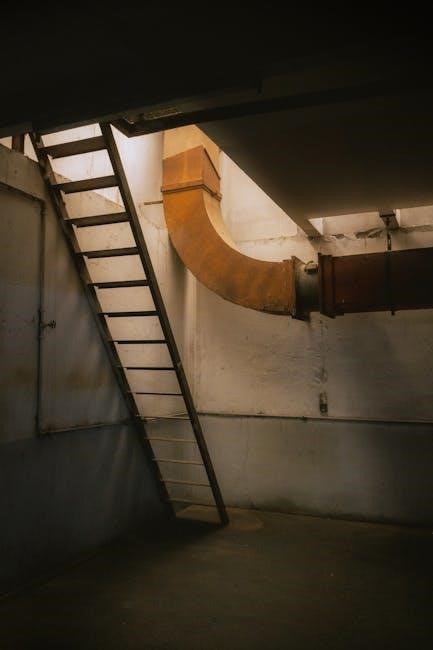
Key Features and Design
Manual air vents are designed with durable materials, ensuring reliability and longevity. Their compact, tamper-proof designs allow for easy installation and operation in various systems.
4.1 Materials Used (Brass, EPDM, etc.)
Manual air vents are typically constructed from durable materials such as brass, EPDM (ethylene-propylene-diene monomer), and stainless steel. Brass is preferred for its corrosion resistance and durability in plumbing systems. EPDM is used for seals and gaskets due to its excellent heat and chemical resistance. These materials ensure long-term reliability and withstand varying operating conditions. High-quality components are chosen to prevent leakage and maintain system integrity, making manual air vents a reliable solution for air management in heating and water systems.
4.2 Operating Pressure and Temperature Limits
Manual air vents are designed to operate within specific pressure and temperature ranges to ensure optimal performance. Typical operating pressures range from 0 to 10 bar, while temperatures can vary from -20°C to 150°C, depending on the application. Exceeding these limits may lead to malfunction or damage. Proper material selection, such as brass or EPDM, ensures the vent can handle the intended operating conditions. Adhering to manufacturer specifications is crucial for reliable and safe operation in heating and plumbing systems.
4.3 Connection Types (Threads, ISO 228, etc.)
Manual air vents are equipped with various connection types to suit different plumbing systems. Threaded connections, such as NPT or BSP, are common due to their reliability and ease of installation. ISO 228 connections offer a standardized thread form, ensuring a tight seal. Flanged connections provide durability and are ideal for larger systems. These options ensure a leak-free seal, which is essential for maintaining system efficiency and preventing air leakage. The choice of connection type depends on the specific application and system requirements.

Installation Guidelines
Proper installation of manual air vents ensures system efficiency and safety. Always follow manufacturer instructions and consider system requirements for correct positioning and functionality.
5.1 Recommended Installation Locations
Manual air vents are typically installed at high points in heating systems, such as radiators, pipes, and expansion tanks. They should be placed where air accumulation is most likely, ensuring efficient air removal. Radiators often require vents at their highest points to prevent airlocks. Additionally, installing vents near pumps or boilers can help maintain system efficiency. Always ensure vents are accessible for maintenance and operation, avoiding locations that may obstruct airflow or system performance.
5.2 Step-by-Step Installation Process
Installing a manual air vent involves several key steps. First, turn off the heating system and allow it to cool. Next, locate the high point in the system where air accumulates. Attach the vent to the pipe using appropriate connections, ensuring a tight seal. Slowly open the system to test for leaks. Finally, operate the vent to release trapped air. Always follow manufacturer instructions for specific models to ensure proper function and system efficiency.
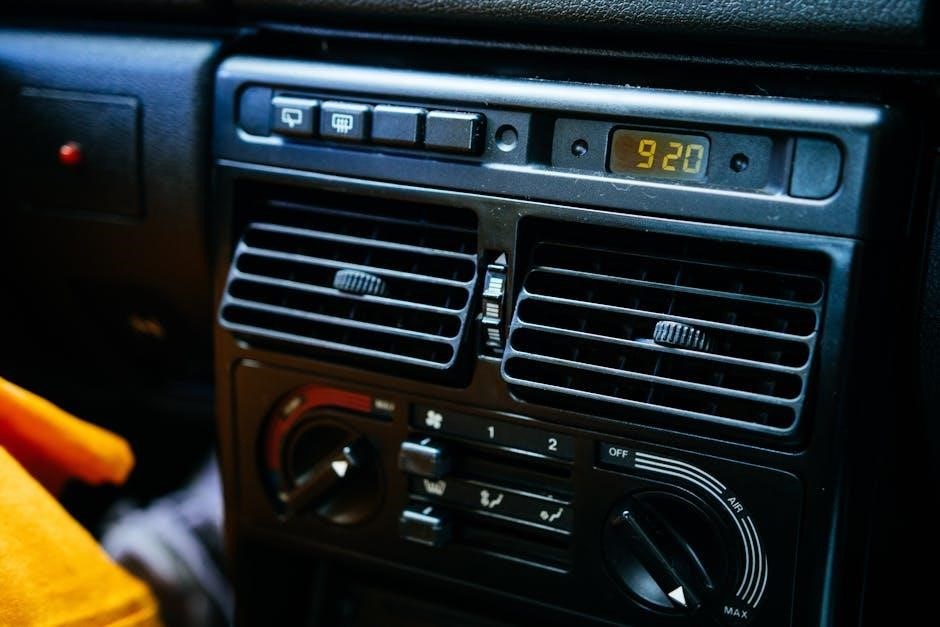
Maintenance and Troubleshooting
Regular inspection and cleaning ensure optimal performance. Lubricate moving parts periodically. Troubleshoot issues like leaks, blockages, or corrosion by replacing worn seals or damaged components promptly.
6.1 Regular Maintenance Tips
Regular maintenance ensures manual air vents function efficiently. Inspect for corrosion, dirt, or mineral buildup monthly. Lubricate moving parts quarterly to prevent sticking. Check connections for tightness and ensure vents are free from blockages. Replace worn seals or gaskets promptly to maintain system integrity. Clean vents with a soft brush or cloth to remove debris. Regularly test vent operation to ensure proper airflow. Addressing issues early prevents system damage and maintains heating efficiency. Always refer to manufacturer guidelines for specific maintenance recommendations.
6.2 Common Issues and Solutions
Common issues with manual air vents include blockages, corrosion, or faulty mechanisms. Blockages can be cleared by cleaning vents with a soft brush or replacing damaged screens. Corrosion requires replacing affected parts with durable materials. Faulty mechanisms may need adjustment or replacement. Leaks at connections can be fixed by tightening or resealing. Addressing these issues promptly ensures proper airflow and system performance. Always follow manufacturer instructions for repairs to avoid further damage. Regular inspections help identify problems early, preventing costly fixes.

Applications of Manual Air Vents
Manual air vents are essential in central heating, radiators, and hot water systems to release trapped air, ensuring efficiency and preventing airlock damage. They also apply in fire sprinkler systems for air management.
7.1 Central Heating Systems
In central heating systems, manual air vents are crucial for eliminating airlocks that prevent proper water circulation. Trapped air in radiators or pipes can cause uneven heating and increased energy bills. By installing manual air vents at high points in the system, air can be released, ensuring efficient heat distribution and system performance. Regular maintenance with these vents helps maintain optimal functionality, reducing the risk of system damage and enhancing overall efficiency.
7.2 Radiators and Hot Water Systems
Manual air vents are essential in radiators and hot water systems to remove trapped air, ensuring efficient heat distribution. Airlocks in radiators can cause uneven heating or complete shutdown of the system. By installing manual vents at strategic high points, air escapes freely, allowing water to circulate properly. This maintains system efficiency and prevents damage from overheating or reduced performance. Regular venting also minimizes energy consumption and extends system lifespan, ensuring reliable operation and consistent heat output.
7.3 Fire Sprinkler Systems
Manual air vents play a crucial role in fire sprinkler systems by ensuring the removal of trapped air during installation, maintenance, and system testing. Airlocks can disrupt water flow, compromising fire safety. By installing manual vents at high points, technicians can vent the system, ensuring pipes are fully charged with water. This is particularly important during hydrostatic testing and routine maintenance to guarantee the system’s reliability and efficiency in emergency situations. Proper venting ensures consistent water pressure and rapid activation of sprinklers when needed.

Safety Considerations
Manual air vents must be handled with care to avoid damage. Always use proper tools and follow manufacturer guidelines to ensure safe operation and system integrity;
8.1 Precautions During Installation
When installing manual air vents, ensure the system is turned off and cooled to prevent scalding. Wear protective gloves and eyewear. Use appropriate tools to avoid damaging threads or valves. Ensure the vent is compatible with the system’s pressure and temperature ratings. Properly size the vent for the system to maintain efficiency. Tighten connections securely but avoid over-tightening, which may cause cracking. Follow manufacturer instructions for orientation and placement to ensure optimal functionality and safety.
8.2 Safe Operating Practices
Open and close manual air vents slowly to avoid sudden pressure changes. Always ensure the system is cool before adjusting vents to prevent burns. Regularly inspect vents for corrosion or damage. Operate vents only when necessary to maintain system efficiency. Keep vents clean from debris to ensure proper airflow. Follow manufacturer guidelines for servicing and replacement. Train personnel on correct operation to prevent misuse. Monitor vent performance to address issues promptly and maintain safe system function.
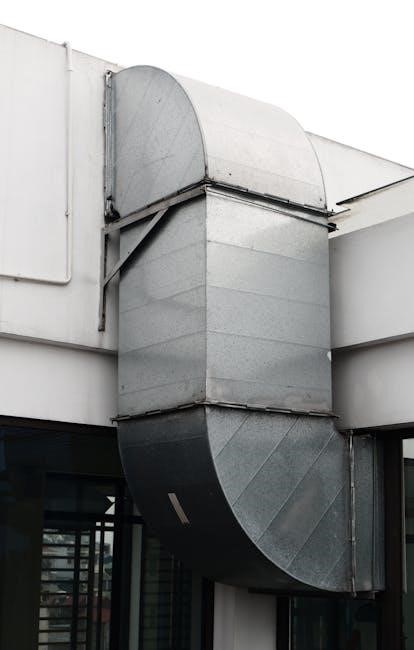
Notable Products and Brands
- Mayevsky Crane offers high-quality manual air vents.
- AGFs 7910MAV is a reliable choice.
- Watts and Caleffi are trusted brands.
9.1 AGFs 7910MAV Manual Air Vent
The AGFs 7910MAV Manual Air Vent is a trusted solution for efficient air elimination in heating systems. Designed with durable materials, it ensures long-lasting performance. Its compact design allows easy installation in various setups. Compatible with multiple pipe sizes, it offers versatility for different applications. The vent operates smoothly, preventing airlocks and maintaining system efficiency. Known for its reliability, it is a preferred choice for professionals and homeowners alike. Its robust construction and user-friendly mechanism make it a standout in the market.
9.2 Mayevsky Crane (Manual Air Vent)
The Mayevsky Crane Manual Air Vent is renowned for its durability and reliability in heating and plumbing systems. Its robust design ensures efficient air elimination, preventing system inefficiencies. Constructed from high-quality materials, it withstands harsh conditions and lasts long. Easy to install and maintain, it is a favorite among professionals. Its simple yet effective mechanism makes it ideal for various applications, ensuring optimal performance and reliability in demanding environments. The Mayevsky Crane is a trusted name, synonymous with quality and dependability in manual air vent solutions.
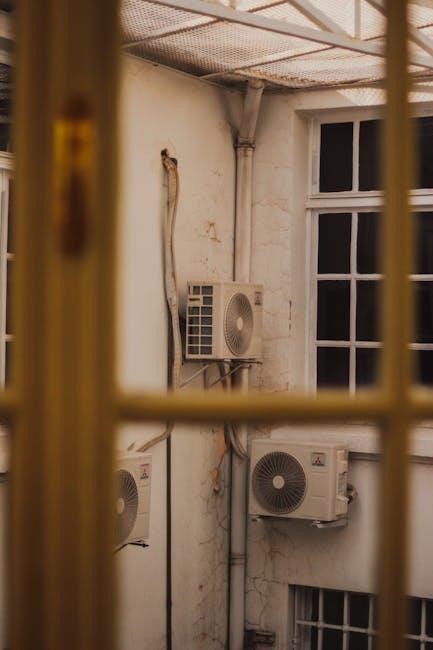
Future Trends and Innovations
Future trends include integration with smart systems for automation and remote monitoring. Advances in materials enhance durability and efficiency, ensuring optimal performance in modern applications.
10.1 Integration with Smart Systems
The integration of manual air vents with smart systems is revolutionizing their functionality. By connecting to IoT-enabled devices, these vents can now be controlled remotely, optimizing airflow and temperature. Sensors embedded in smart systems detect pressure imbalances and automatically adjust vents, ensuring efficient operation. This seamless integration enhances system performance, reduces manual intervention, and improves energy efficiency. Smart systems also enable real-time monitoring and data collection, providing insights for better maintenance and energy management, making manual air vents more versatile in modern setups.
10.2 Advancements in Material Technology
Advancements in material technology have significantly enhanced the durability and performance of manual air vents. Modern materials like high-performance plastics and advanced brass alloys offer improved corrosion resistance and thermal stability. Innovations in EPDM (ethylene propylene diene monomer) and other elastomers provide better sealing capabilities and longevity. These developments ensure vents can withstand harsh environments while maintaining optimal airflow and system integrity. Such advancements are critical for improving reliability and reducing maintenance needs in heating and plumbing systems.
Manual air vents are essential for efficient heating systems, ensuring reliability and performance. Their simplicity and effectiveness make them a crucial component in modern plumbing solutions.
11.1 Summary of Key Points
Manual air vents play a vital role in heating systems by eliminating airlocks, ensuring efficient operation, and prolonging system lifespan. Available in various types, they offer versatility for different applications. Proper installation and maintenance are crucial for optimal performance. Common issues like leakage or blockage can be resolved with simple troubleshooting. Their integration into systems like radiators and fire sprinklers highlights their importance. With advancements in materials and smart technology, manual air vents continue to evolve, remaining a cornerstone of modern plumbing solutions.
11.2 Final Thoughts on Manual Air Vents
Manual air vents remain indispensable for maintaining efficient and reliable heating systems. Their simplicity and effectiveness make them a cornerstone of plumbing solutions. While advancements in technology offer new possibilities, the fundamental role of manual air vents endures. Proper maintenance ensures longevity, while their adaptability to various systems underscores their enduring relevance. As innovation progresses, these vents continue to be a vital component, blending tradition with modern demands for performance and sustainability.
